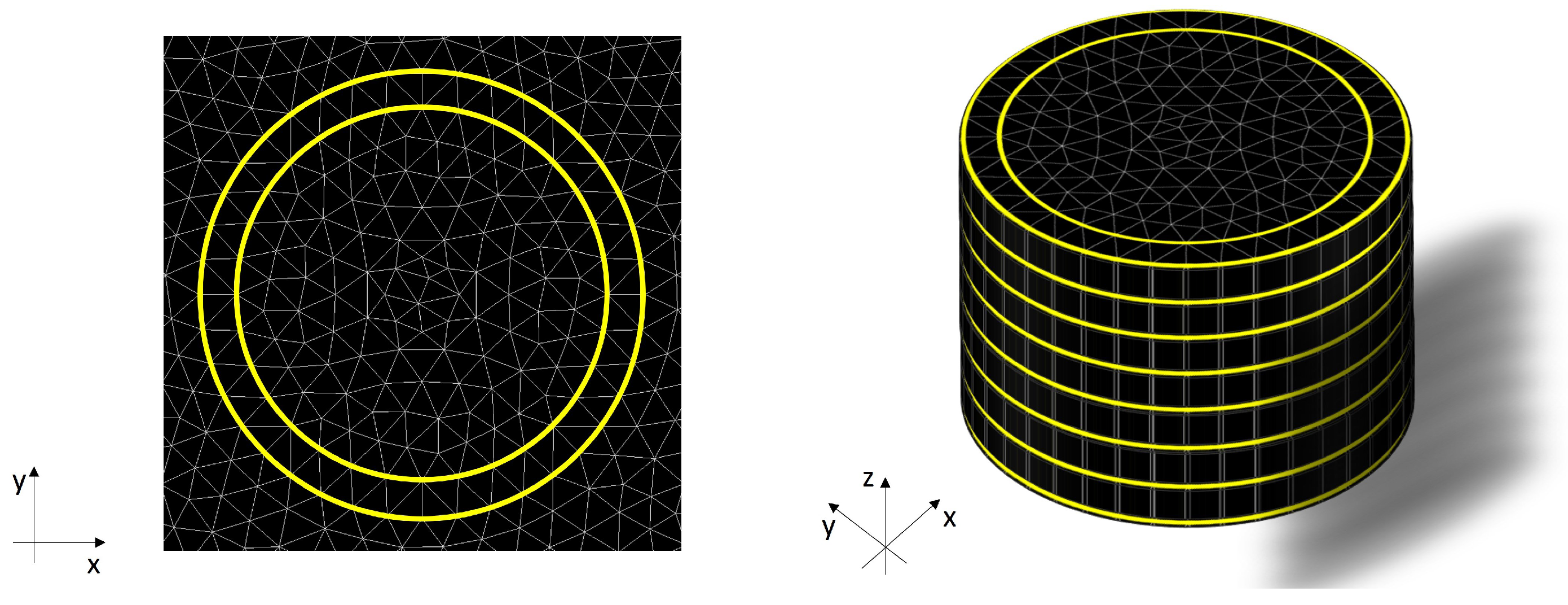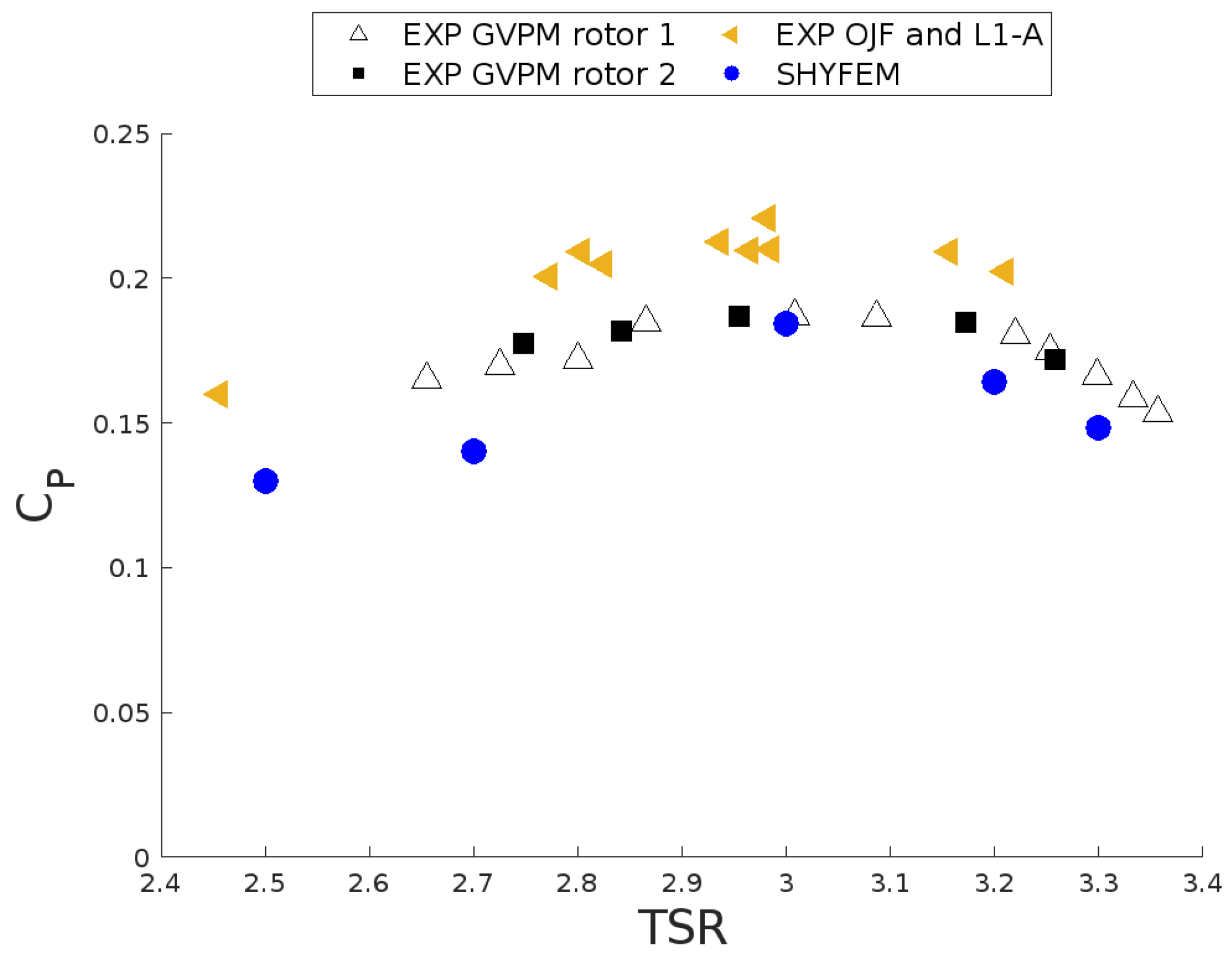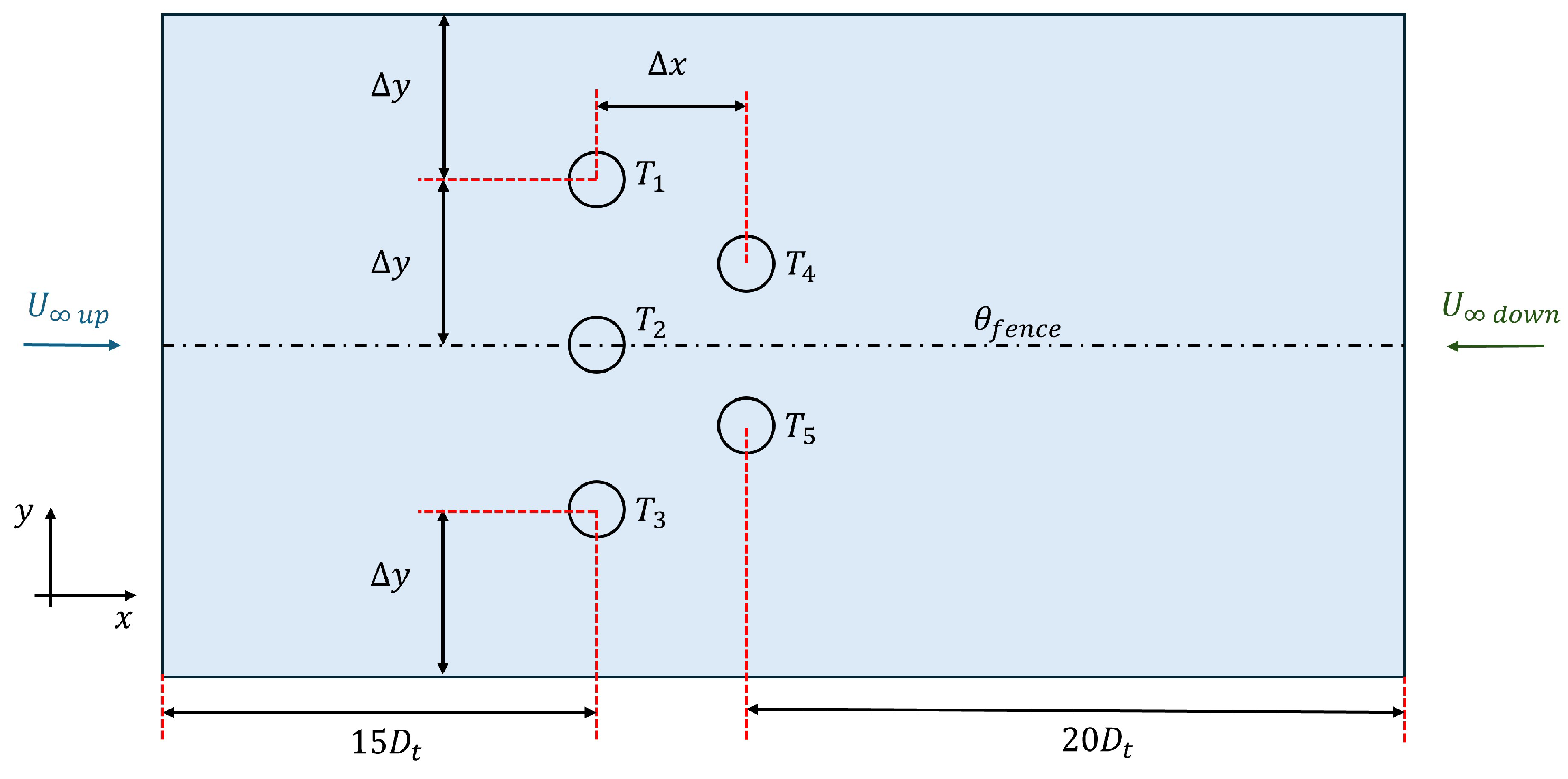Vertical-Axis Tidal Turbines: Model Development and Farm Layout Design
Abstract
:1. Introduction
2. Model Development
Sub-Models
3. Validation
3.1. Performance Validation
3.2. Wake Validation
4. Sensitivity Analysis
5. Turbines Interactions
6. Farm Design
6.1. Spacing between Devices in a Fence
6.2. Spacing between Fences
7. Results
8. Conclusions
Author Contributions
Funding
Data Availability Statement
Conflicts of Interest
References
- Zhang, C.; Kramer, S.C.; Angeloudis, A.; Zhang, J.; Lin, X.; Piggott, M.D. Improving tidal turbine array performance through the optimisation of layout and yaw angles. Int. Mar. Energy J. 2022, 5, 273–280. [Google Scholar] [CrossRef]
- Funke, S.W.; Kramer, S.C.; Piggott, M.D. Design optimisation and resource assessment for tidal-stream renewable energy farms using a new continuous turbine approach. Renew. Energy 2016, 99, 1046–1061. [Google Scholar] [CrossRef]
- García-Oliva, M.; Djordjević, S.; Tabor, G.R. The impacts of tidal turbines on water levels in a shallow estuary. Int. J. Mar. Energy 2017, 19, 177–197. [Google Scholar] [CrossRef]
- Brown, A.J.G.; Neill, S.P.; Lewis, M.J. Tidal energy extraction in three-dimensional ocean models. Renew. Energy 2017, 114, 244–257. [Google Scholar] [CrossRef]
- Robins, P.E.; Neill, S.P.; Lewis, M.J. Impact of tidal-stream arrays in relation to the natural variability of sedimentary processes. Renew. Energy 2014, 72, 311–321. [Google Scholar] [CrossRef]
- De Dominicis, M.; Murray, R.O.; Wolf, J. Multi-scale ocean response to a large tidal stream turbine array. Renew. Energy 2017, 114, 1160–1179. [Google Scholar] [CrossRef]
- Deng, G.; Zhang, Z.; Li, Y.; Liu, H.; Xu, W.; Pan, Y. Prospective of development of large-scale tidal current turbine array: An example numerical investigation of Zhejiang, China. Appl. Energy 2020, 264, 114621. [Google Scholar] [CrossRef]
- Ramos, V.; Carballo, R.; Sanchez, M.; Veigas, M.; Iglesias, G. Tidal stream energy impacts on estuarine circulation. Energy Convers. Manag. 2014, 80, 137–149. [Google Scholar] [CrossRef]
- Ramos, V.; Carballo, R.; Ringwood, J.V. Application of the actuator disc theory of Delft3D-FLOW to model far-field hydrodynamic impacts of tidal turbines. Renew. Energy 2019, 139, 1320–1335. [Google Scholar] [CrossRef]
- Thiébot, J.; Guillou, S.; Nguyen, V.T. Modelling the effect of large arrays of tidal turbines with depth-averaged Actuator Disks. Ocean Eng. 2016, 126, 265–275. [Google Scholar] [CrossRef]
- Roc, T.; Conley, D.C.; Greaves, D. Methodology for tidal turbine representation in ocean circulation model. Renew. Energy 2013, 51, 448–464. [Google Scholar] [CrossRef]
- Lin, J.; Sun, J.; Liu, L.; Chen, Y.; Lin, B. Refined representation of turbines using a 3D SWE model for predicting distributions of velocity deficit and tidal energy density. Int. J. Energy Res. 2015, 39, 1828–1842. [Google Scholar] [CrossRef]
- Pucci, M.; Di Garbo, C.; Bellafiore, D.; Zanforlin, S.; Umgiesser, G. A BEM-Based Model of a Horizontal Axis Tidal Turbine in the 3D Shallow Water Code SHYFEM. J. Mar. Sci. Eng. 2022, 10, 1864. [Google Scholar] [CrossRef]
- SHYFEM-Model. Available online: https://github.com/SHYFEM-model/shyfem (accessed on 6 March 2024).
- Ouro, P.; Stoesser, T. An immersed boundary-based large-eddy simulation approach to predict the performance of vertical axis tidal turbines. Comput. Fluids 2017, 152, 74–87. [Google Scholar] [CrossRef]
- Zanforlin, S. Advantages of vertical axis tidal turbines set in close proximity: A comparative CFD investigation in the English Channel. Ocean Eng. 2018, 156, 358–372. [Google Scholar] [CrossRef]
- Zheng, H.D.; Zheng, X.; Zhao, S. Arrangement of clustered straight-bladed wind turbines. Energy 2020, 200, 117563. [Google Scholar] [CrossRef]
- Sun, K.; Ji, R.; Zhang, J.; Li, Y.; Wang, B. Investigations on the hydrodynamic interference of the multi-rotor vertical axis tidal current turbine. Renew. Energy 2021, 169, 752–764. [Google Scholar] [CrossRef]
- Shamsoddin, S.; Porté-Agel, F. A large-eddy simulation study of vertical axis wind turbine wakes in the atmospheric boundary layer. Energies 2016, 9, 366. [Google Scholar] [CrossRef]
- Ouro, P.; Dené, P.; Garcia-Novo, P.; Stallard, T.; Kyozuda, Y.; Stansby, P. Power density capacity of tidal stream turbine arrays with horizontal and vertical axis turbines. J. Ocean Eng. Mar. Energy 2023, 9, 203–218. [Google Scholar] [CrossRef]
- Jégo, L.; Guillou, S.S. Study of a bi-vertical axis turbines farm using the actuator cylinder method. Energies 2021, 14, 5199. [Google Scholar] [CrossRef]
- Rocchio, B.; Chicchiero, C.; Salvetti, M.V.; Zanforlin, S. A simple model for deep dynamic stall conditions. Wind Energy 2020, 23, 915–938. [Google Scholar] [CrossRef]
- Migliore, P.; Wolfe, W.; Fanucci, J. Flow curvature effects on Darrieus turbine blade aerodynamics. J. Energy 1980, 4, 49–55. [Google Scholar] [CrossRef]
- Vergaerde, A.; De Troyer, T.; Muggiasca, S.; Bayati, I.; Belloli, M.; Kluczewska-Bordier, J.; Parneix, N.; Silvert, F.; Runacres, M.C. Experimental characterisation of the wake behind paired vertical-axis wind turbines. J. Wind. Eng. Ind. Aerodyn. 2020, 206, 104353. [Google Scholar] [CrossRef]
- Vergaerde, A.; De Troyer, T.; Standaert, L.; Kluczewska-Bordier, J.; Pitance, D.; Immas, A.; Silvert, F.; Runacres, M.C. Experimental validation of the power enhancement of a pair of vertical-axis wind turbines. Renew. Energy 2020, 146, 181–187. [Google Scholar] [CrossRef]
- Brusca, S.; Lanzafame, R.; Messina, M. Flow similitude laws applied to wind turbines through blade element momentum theory numerical codes. Int. J. Energy Environ. Eng. 2014, 5, 313–322. [Google Scholar] [CrossRef]
- Jump, E.; Macleod, A.; Wills, T. Review of tidal turbine wake modelling methods: State of the art. Int. Mar. Energy J. 2020, 3, 91–100. [Google Scholar] [CrossRef]
- Hunt, A.; Stringer, C.; Polagye, B. Effect of aspect ratio on cross-flow turbine performance. J. Renew. Sustain. Energy 2020, 12, 054501. [Google Scholar] [CrossRef]
- Vogel, C.; Houlsby, G.; Willden, R. Effect of free surface deformation on the extractable power of a finite width turbine array. Renew. Energy 2016, 88, 317–324. [Google Scholar] [CrossRef]
- Whelan, J.I.; Graham, J.; Peiro, J. A free-surface and blockage correction for tidal turbines. J. Fluid Mech. 2009, 624, 281–291. [Google Scholar] [CrossRef]
- Zanforlin, S. Effects of hydrofoil shape and turbine solidity on the wake energy recovery in cross-flow turbines. J. Ocean Eng. Mar. Energy 2023, 9, 547–566. [Google Scholar] [CrossRef]
- Zanforlin, S.; Lupi, P. Investigation of the wake energy recovery of cross-flow turbines in paired configuration by means of 3d-CFD and analysis of the streamwise momentum budget. In Proceedings of the 76th Italian National Congress ATI (ATI 2021), Rome, Italy, 15–17 September 2021; E3S Web of Conferences. Volume 312, p. 08011. [Google Scholar]
- Pucci, M.; Zanfrolin, S. Tidal Farms: Optimising site-specific layouts by combining analytical methods and fluid dynamic simulations. In Proceedings of the International Conference on Artificial Intelligence, Computer, Data Sciences and Applications (ACDSA 2024), Victoria, Seychelles, 1–2 February 2024; pp. 463–468. [Google Scholar]
- Bachant, P.; Wosnik, M. Reynolds number dependence of cross-flow turbine performance and near-wake characteristics. In Proceedings of the 2nd Marine Energy Technology Symposium, Seattle, WA, USA, 15–18 April 2014. [Google Scholar]
- Pucci, M.; Bellafiore, D.; Zanforlin, S.; Frangioni, A. A turbines-module adapted to the marine site for tidal farms layout optimization. In Proceedings of the European Wave and Tidal Energy Conference, Bilbao, Spain, 3–7 September 2023; Volume 15. [Google Scholar]
- El Tawil, T.; Guillou, N.; Charpentier, J.F.; Benbouzid, M. On tidal current velocity vector time series prediction: A comparative study for a French high tidal energy potential site. J. Mar. Sci. Eng. 2019, 7, 46. [Google Scholar] [CrossRef]
- Lande-Sudall, D.; Stallard, T.; Stansby, P. Co-located offshore wind and tidal stream turbines: Assessment of energy yield and loading. Renew. Energy 2018, 118, 627–643. [Google Scholar] [CrossRef]
- Piano, M.; Neill, S.; Lewis, M.; Robins, P.; Hashemi, M.R.; Davies, A.; Ward, S.; Roberts, M. Tidal stream resource assessment uncertainty due to flow asymmetry and turbine yaw misalignment. Renew. Energy 2017, 114, 1363–1375. [Google Scholar] [CrossRef]
















| Validation Setup | |
|---|---|
| x domain extension | 40 m |
| y domain extension | 10 m |
| z domain extension | 10 m |
| Turbine chord (c) | 0.05 m |
| Turbine diameter () | 0.5 m |
| Turbine height () | 0.80 m |
| Hydrofoil | NACA0018 |
| Number of blades | 2 |
| Depth of the turbine centre | 2.5 m |
| Distance from the inlet | 40 |
| Distance from the outlet | 40 |
| Undisturbed flow velocity | 0.72 m/s |
| h res [m] | Layer [m] | |
|---|---|---|
| 0.22 | 0.025 | 0.05 |
| 0.24 | 0.05 | 0.05 |
| 0.27 | 0.1 | 0.05 |
| 0.24 | 0.05 | 0.025 |
| 0.24 | 0.05 | 0.1 |
| 0.23 | 0.025 | 0.025 |
| 0.26 | 0.1 | 0.1 |
| 0.34 | 0.15 | 0.15 |
| 2 | 2 | 0.280 |
| 3 | 0.262 | |
| 4.5 | 0.242 | |
| 7 | 0.231 | |
| 3 | 2 | 0.301 |
| 3 | 0.298 | |
| 4.5 | 0.284 | |
| 7 | 0.257 | |
| 4.5 | 2 | 0.300 |
| 3 | 0.299 | |
| 4.5 | 0.296 | |
| 7 | 0.284 | |
| 7 | 2 | 0.296 |
| 3 | 0.295 | |
| 4.5 | 0.293 | |
| 7 | 0.292 |
Disclaimer/Publisher’s Note: The statements, opinions and data contained in all publications are solely those of the individual author(s) and contributor(s) and not of MDPI and/or the editor(s). MDPI and/or the editor(s) disclaim responsibility for any injury to people or property resulting from any ideas, methods, instructions or products referred to in the content. |
© 2024 by the authors. Licensee MDPI, Basel, Switzerland. This article is an open access article distributed under the terms and conditions of the Creative Commons Attribution (CC BY) license (https://creativecommons.org/licenses/by/4.0/).
Share and Cite
Pucci, M.; Spina, R.; Zanforlin, S. Vertical-Axis Tidal Turbines: Model Development and Farm Layout Design. Energies 2024, 17, 2366. https://doi.org/10.3390/en17102366
Pucci M, Spina R, Zanforlin S. Vertical-Axis Tidal Turbines: Model Development and Farm Layout Design. Energies. 2024; 17(10):2366. https://doi.org/10.3390/en17102366
Chicago/Turabian StylePucci, Micol, Raffaele Spina, and Stefania Zanforlin. 2024. "Vertical-Axis Tidal Turbines: Model Development and Farm Layout Design" Energies 17, no. 10: 2366. https://doi.org/10.3390/en17102366
APA StylePucci, M., Spina, R., & Zanforlin, S. (2024). Vertical-Axis Tidal Turbines: Model Development and Farm Layout Design. Energies, 17(10), 2366. https://doi.org/10.3390/en17102366









